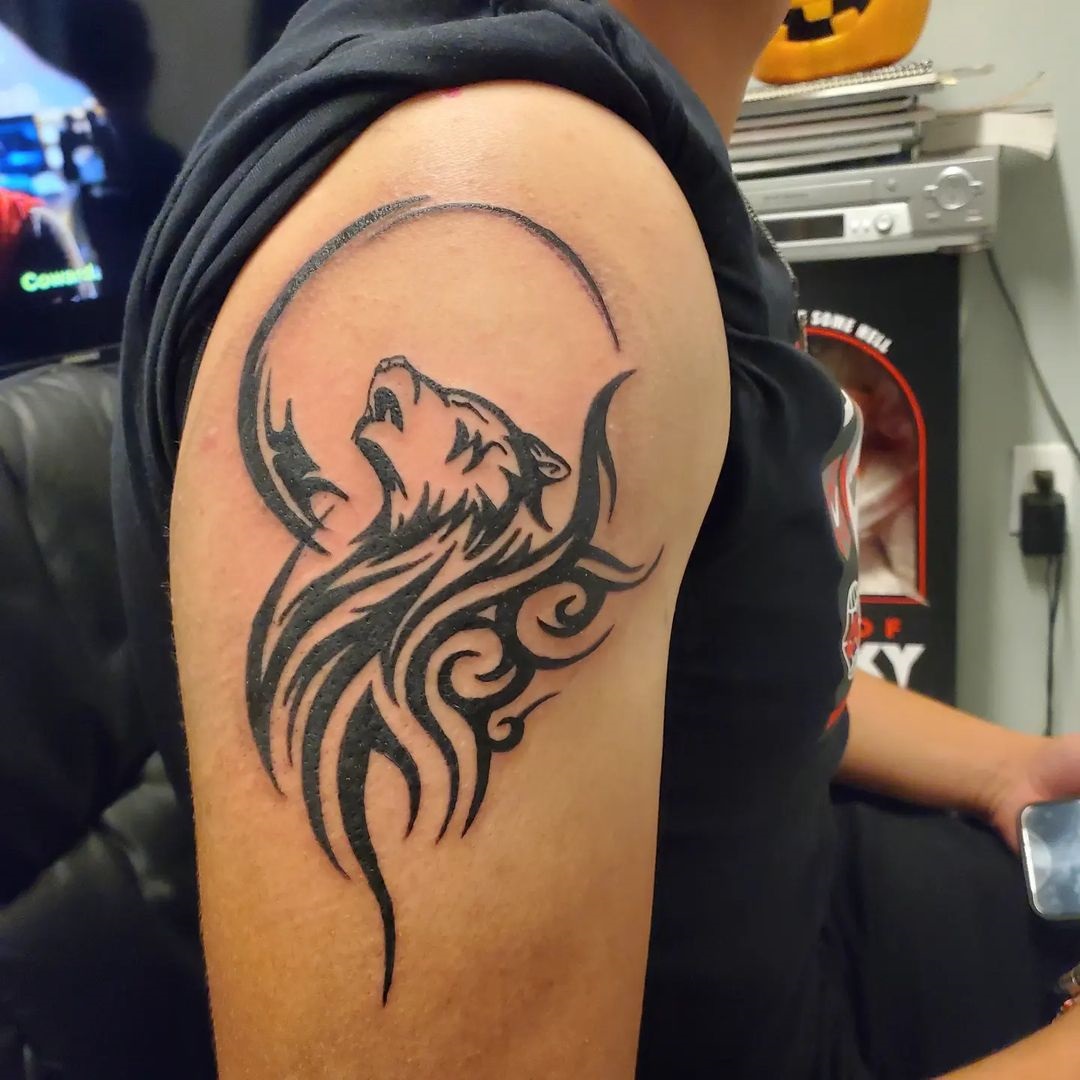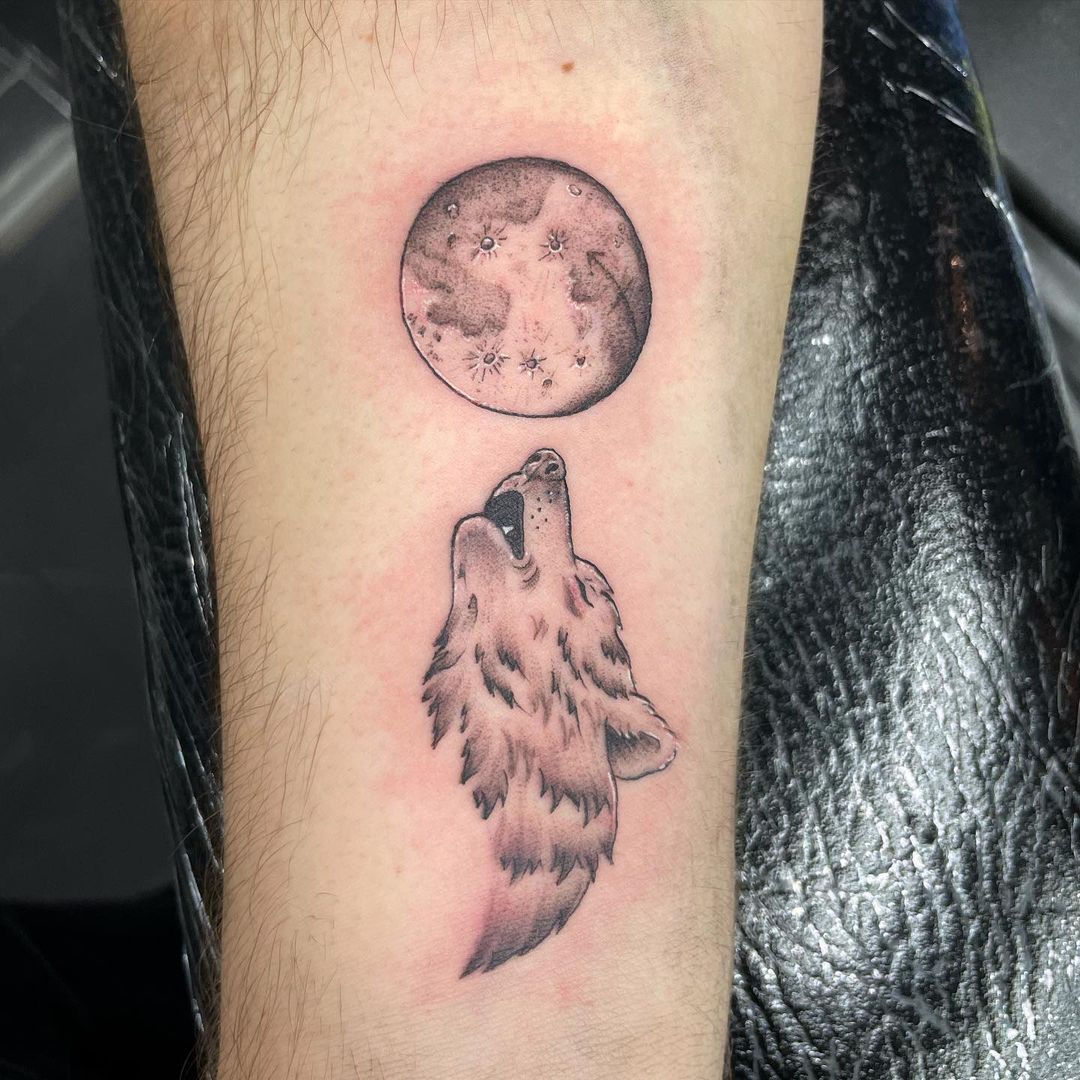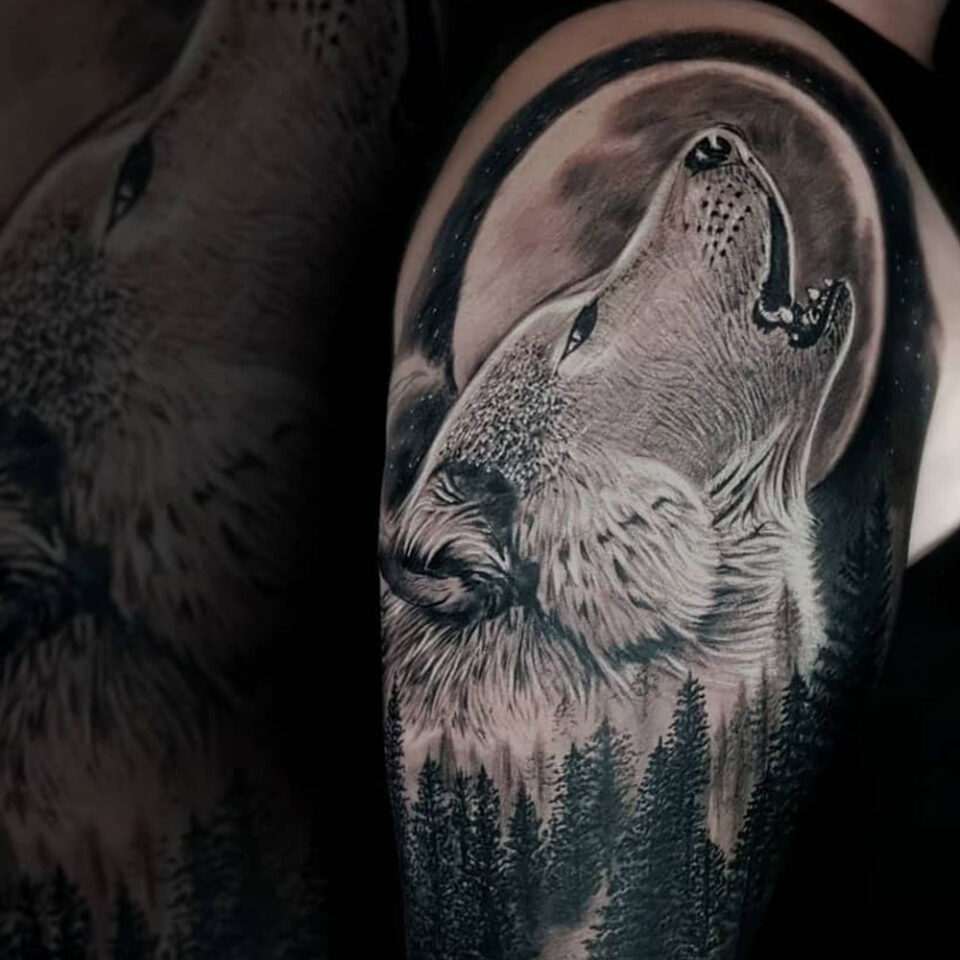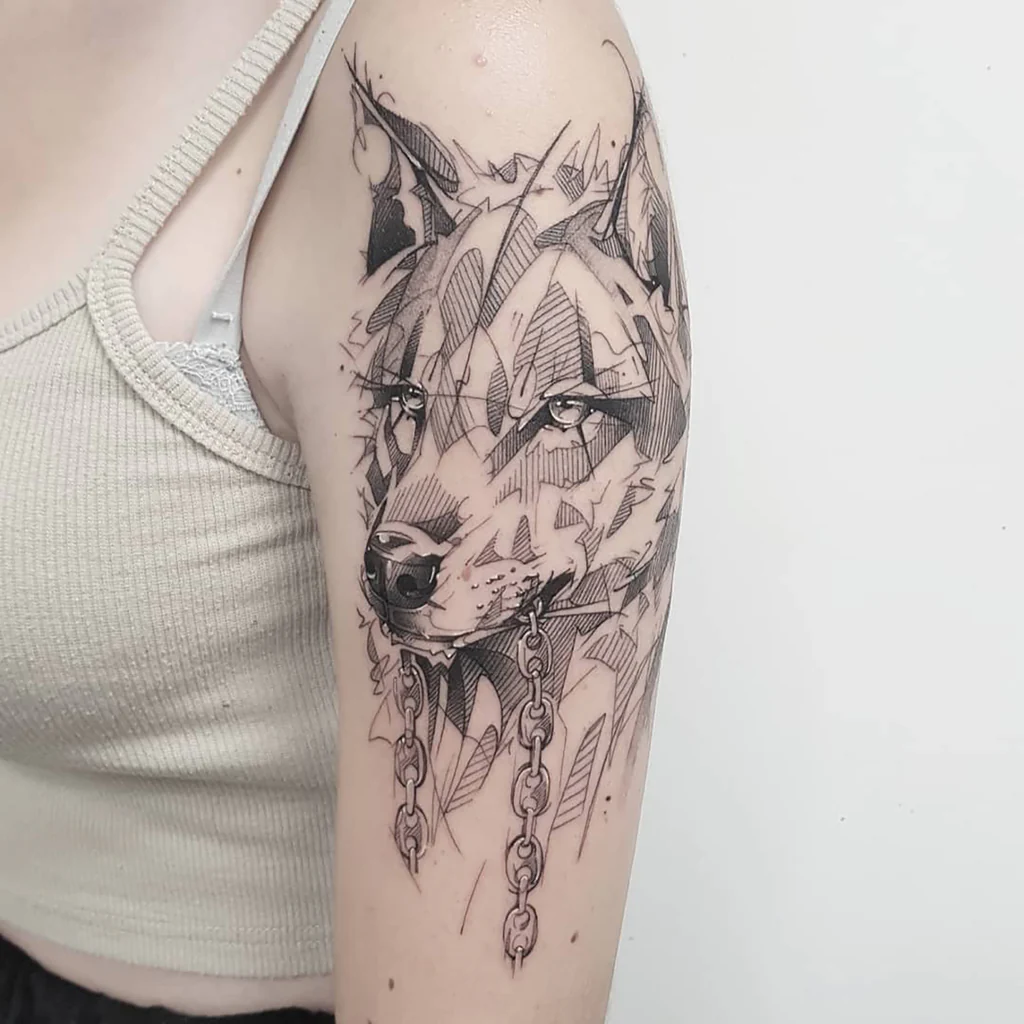
Wolf Tattoo Meanings & Design Inspirations
The Symbolism Behind Wolf Tattoos
The wolf is a powerful symbol in many cultures. Wolf tattoos may represent strength, freedom, and intelligence. They often symbolize a person’s survival through hard times. In some traditions, wolves are seen as protectors. This makes wolf tattoos a sign of guidance or guardianship.
For others, the lone wolf aspect represents independence and self-reliance. In a pack, wolves display loyalty, communication, and deep family ties. Wolf tattoos can thus also symbolize community and belonging. Nature and the wild, howling at the moon, are images often linked with wolf tattoos, suggesting a connection with primal instincts.
Wolves also play a role in myths and stories from various cultures. In Norse mythology, for example, wolves are both feared and revered. This ambivalence adds depth to the wolf tattoo’s meaning. It can symbolize the struggle between civilized society and wild nature. A wolf tattoo can capture this duality—the balance of good and evil, or chaos and order.
People choose wolf tattoos for personal reasons too. They might represent an important life event, personal achievement, or a tribute to a loved one. Such tattoos can be a daily reminder of the wearer’s personal meaning and symbolism. Affinity for the animal itself is also a common reason for choosing a wolf tattoo. For many, it’s a favorite animal or one they feel a spiritual connection to.
In the world of ink, a wolf tattoo is versatile and can hold varied meanings. It is an expression of a multi-faceted symbol that has personal and universal significance.

Popular Wolf Tattoo Styles and Designs
Wolf tattoos come in a range of styles and designs, each with its own appeal. Bold tribal designs with their thick lines and patterns give a sense of strength and courage. Realistic wolf tattoos, showcasing the animal’s detailed fur and piercing eyes, can display one’s admiration for the wolf’s natural beauty.
Traditional American tattoos often feature wolves with iconic elements like roses, daggers, or moons. These classic tattoos carry a vintage charm and a connection to tattoo history. Meanwhile, geometric wolf tattoos play with shapes and symmetry, often merging the wolf’s image with abstract patterns.
Watercolor wolf tattoos are becoming more popular for their artistic touch. They mimic a painting with splashes of color blurring the lines of the wolf, emphasizing creativity and emotion. Dotwork, another trendy style, uses countless dots to create the wolf’s image, showing off precision and patience in the art.
Japanese style wolf tattoos are intricate, incorporating folklore elements and vibrant colors. These tattoos can look mystical and convey spiritual beliefs. On the other side, minimalist wolf tattoos with clean lines and simplicity appeal to those who favor a subtle nod to the wolf’s symbolism.
Black and grey wolf tattoos can evoke a sense of mystery and are often chosen for their timeless look. These tattoos work well in various sizes and forms, fitting different body parts for a personalized meaning or aesthetic.
Choosing a wolf tattoo style and design is about finding a visual representation that resonates with personal symbolism. Whether you aim for a representation of strength, family ties, or a spiritual connection, the designs are nearly as diverse as the meanings they hold.

Cultural Significance of Wolf Tattoos
In the vast world of symbols, wolf tattoos hold a special place across cultures. These designs not only embody personal meanings but also embrace widespread cultural significance. Let’s explore the cultural aspects that make wolf tattoos so profound.
In Native American Cultures
In Native American tradition, the wolf is a crucial totem animal. Tribes view the wolf as a guide in the spirit world. They believe it offers wisdom, protection, and support. Wolf tattoos hence may reflect respect for this spiritual guidance. They can honor one’s heritage or show a bond with these natural teachings.
In Asian Lore
Asian cultures regard the wolf differently. In some legends, wolves are noble creatures. They symbolize loyalty and guardianship. For instance, in Mongolian history, the wolf is an ancestor of Genghis Khan, lending wolf tattoos a sense of pride and lineage.
In European Stories
European tales often depict wolves as wild and sometimes negative forces. However, they also represent freedom and the untouched aspects of nature. In these contexts, carrying a wolf tattoo can suggest a defiance of societal constraints or a yearning for untamed existence.
Globally Understood Themes
No matter the culture, certain themes emerge. Strength, leadership, and intuition are qualities tied globally to the wolf. Tattoos featuring this majestic animal can communicate these universal values, connecting wearers from different backgrounds.
Overall, wolf tattoos transcend personal preference and tap into the collective consciousness of human culture. They can be a powerful way to honor the past, celebrate the present, or even guide one’s future based on this shared global heritage. With every inked wolf, there’s a story woven into the skin that crosses timelines and territories, making each tattoo uniquely significant in a cultural light.
Placement Ideas for Wolf Tattoos
When you decide to get a wolf tattoo, choosing the right spot for it is key. The placement can affect the tattoo’s visibility and your level of comfort during the inking process.
Consider Your Pain Tolerance
Some areas of the body are more sensitive than others. Common places for wolf tattoos include the arms, back, chest, and thighs. These areas generally handle pain better. Wrists, ankles, and ribs might be more painful spots.
Think About Size and Detail
If you want a larger, more detailed wolf tattoo, consider spaces like the back or thigh. Smaller tattoos work well on the arms, wrists, or ankles. Detail matters, too; intricate designs need enough space to be appreciated.
Visibility and Personal Expression
Ask yourself how visible you want your wolf tattoo to be. Hidden placements offer a personal reminder. Visible tattoos can make a public statement about your values or style.
Professional Considerations
If you work in a conservative field, think about how your tattoo might be perceived. Choose a spot that’s easy to cover with clothing if needed. Common coverable areas include the upper arms, back, and chest.
Combine Placement with Style
The placement should match the chosen design style. For instance, bold tribal wolf tattoos might look best on the arm or shoulder. Minimalist designs could suit smaller, discrete areas like the ankle. Geometric or watercolor tattoos might need a broad canvas, such as the back, to capture their detail.
Ultimately, where you place your wolf tattoo should harmonize with your personal preferences, professional life, and comfort. It’s your story on your skin; make sure it’s told the way you want it to be.

Color Schemes in Wolf Tattoo Art
Choosing the right color scheme for your wolf tattoo is as crucial as the design itself.
Go Monochrome with Black and Grey
The classic black and grey palette can create a dramatic and timeless look. These tones can reflect the wolf’s wild nature and add a sense of mysticism. Simplicity in color can be powerful, often accentuating the tattoo’s emotional resonance.
Injections of Color for Vibrancy
For a more vibrant piece, color can be injected. Blues and greens can propose tranquility or connection to nature, while reds might represent passion or a fighting spirit. More elaborate color schemes can bring a wolf tattoo to life in unique ways.
Natural Tones for Realism
If realism is what you’re after, natural tones mirroring the wolf’s actual fur colors are ideal. Browns, tans, and whites help to create a lifelike and authentic look. This color choice can highlight the beauty and detail of a realistic wolf tattoo style.
Choosing colors that offer personal meaning is key. Whether you prefer a subtle, monochromatic look or a vivid, multi-hued design, color plays an integral role. It can enhance the overall impact and message of your wolf tattoo. Remember to consider how the colors might fade over time and choose ones that will age gracefully with your skin. Your tattoo artist can offer guidance on selecting colors that will look best for the long term.

The Process of Getting a Wolf Tattoo
Choosing to get a wolf tattoo is exciting. Here’s what to expect:
Consultation with the Tattoo Artist
First, you need to talk with a tattoo artist. Discuss your ideas, preferred styles, and placements for your wolf tattoo. The artist will help refine your vision and offer advice on what will work best for your body.
Design Phase
After talking, the artist will create your tattoo design. This may take some time. They will sketch out your wolf tattoo, often presenting you with options or adjustments. Your input is crucial to ensure the final design matches your desires.
Appointment and Preparation
Once the design is set, you’ll book your tattoo session. Prepare by getting a good night’s sleep and staying hydrated. Wear comfortable clothing that offers easy access to the area where you’ll get tattooed.
The Tattooing Process
During your appointment, the artist will transfer the design onto your skin. The process starts with outlining and is followed by shading and coloring. Stay still and follow the artist’s instructions. This can take a few hours, depending on the size and complexity of your wolf tattoo.
Immediate Aftercare
Directly after the tattooing, your artist will clean the area. They’ll cover your new tattoo with a bandage. They’ll give you aftercare instructions to follow to make sure your wolf tattoo heals well and retains its quality.
Healing Time
Healing usually takes a few weeks. Keep the tattoo clean and moisturized. Avoid sun exposure and follow all aftercare steps. Your skin may feel itchy or peel, but this is normal during the healing process.
Each step in getting a wolf tattoo is part of a memorable journey. Trust your artist, care for your tattoo, and soon you’ll have a meaningful piece of art to cherish for life.

Aftercare Tips for Your Wolf Tattoo
Taking care of your new wolf tattoo is vital for its longevity and beauty. Proper aftercare is essential to prevent infection and ensure that your tattoo heals properly. Here are tips to help keep your wolf tattoo looking sharp and vibrant long after leaving the tattoo parlor.
Follow Your Tattoo Artist’s Instructions
Your artist knows best. Stick to the aftercare advice given to you. This typically includes keeping the tattoo clean, applying ointment, and not picking at scabs.
Keep the Tattoo Clean
Gently wash your tattoo with mild soap and water. Do this 2-3 times a day. Pat it dry with a clean, soft towel.
Apply the Right Ointment
Use the recommended ointment or lotion. Apply a thin layer to the tattoo. This keeps the skin moist and aids healing.
Avoid Sun Exposure
Keep your wolf tattoo away from direct sunlight. UV rays can fade the ink and damage the skin. When going out, cover the area or use a high-SPF sunscreen.
Wear Loose Clothing
Choose clothes that don’t rub against your tattoo. Tight clothing can cause irritation and may affect the ink’s appearance.
Stay Hydrated
Drink plenty of water. Hydration helps your skin heal faster and more effectively.
Avoid Pools and Hot Tubs
Stay out of pools, hot tubs, and seawater while your tattoo heals. Chlorine and bacteria may lead to infections.
Be Patient with Healing
Healing times vary. Your wolf tattoo may take up to a few weeks to fully heal. Don’t rush the process. Let your body do its work.
Seek Medical Advice If Necessary
If you notice any signs of infection, such as excessive redness, swelling, or pain, consult a doctor immediately.
By faithfully following these aftercare tips, you’ll help ensure that your wolf tattoo remains as striking and meaningful as the day you got it. Whether your tattoo celebrates the strength, freedom, or family ties that wolves represent, taking proper care of it will preserve its symbolism and beauty for years to come.
Examples of Stunning Wolf Tattoo Artwork
Seeing real examples can spark inspiration for your own wolf tattoo design. Here are some impressive artworks:
Realistic Wolf Portraits
Realistic wolf tattoos capture the raw beauty of the animal. Artists can create lifelike fur textures and expressive eyes that make the wolf come alive on skin.
Tribal Wolf Designs
Tribal wolf tattoos, with bold lines and forms, can convey power and mysticism. These designs reflect a connection to ancient traditions and the primal strength of the wolf.
Geometric Wolves
Geometric wolf tattoos blend the wild spirit of the creature with modern artistry. Sharp angles and shapes form the wolf’s visage, often resulting in a visually captivating piece.
Watercolor Wolves
For a more artistic and abstract look, watercolor wolf tattoos show bursts of color flowing and blending, symbolizing creativity and freedom.
Minimalist Wolf Silhouettes
Simple yet profound, minimalist wolf tattoos consist of clean lines forming a sleek silhouette. This style is perfect for a subtle yet meaningful representation.
Japanese-Inspired Wolves
Intricate and vibrant, Japanese-style wolf tattoos often include elements of folklore and are rich in symbolism, perfect for a more elaborate tattoo narrative.
Each of these examples exhibits the depth and versatility of wolf tattoos, and they serve as a testament to the wolf’s enduring appeal in tattoo culture. Whether you prefer the intimacy of small, understated designs or the boldness of large, intricate works, the wolf tattoo lends itself to a variety of artful expressions.

